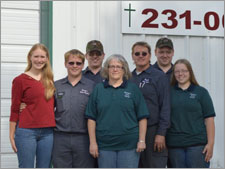
Call
620-231-0072 for service.
WHAT YOU NEED TO KNOW ABOUT YOUR CAR
IF YOU EVER HAVE TO GET PARTS FOR YOU CAR YOU WILL NEED TO KNOW THESE THINGS TO GET THE RIGHT PART.
1.Year make and model of your car.
You can look at the title of your car or the vehicle registration to find out this information.
You can also look at the Vehicle Identification Number. You can usually see this number by looking through the windshield on the bottom drivers side. On vehicles 1981 and newer this is a 17 digit number and letter combinations. You can determine the year of your vehicle by the 10 digit. B = 1981, C=1982 and so on. The LETTERS "I" and "O" are never used. H=1987 and J=1988. Y=2000. For a 2001 model a 1 is used. For a 2002 a 2 is used and so on. So to determine the year of your car you can look at the 10 digit of the VIN.
2. Engine size and transmission type.
The engine in your car has a number of engine size possibilities. The number of cylinders means the number of pistons that your engine has. Most cars and light duty trucks will have 4, 6 or 8 cylinders. Although some have 3, 5 and even 10 cylinders. There are V type engines which have an equal # of cylinders on each side with the cylinders arranged in a v shape. Some are an inline design- all cylinders in a straight line. You can find the size on the emissions sticker that is under the hood. This is a sticker about 8 inches wide and 2 inches high. Usually the engine size is in the upper left corner. Sometimes the size is cast into part of the engine. Usually this is very visible when looking at the engine. 2.4 liter or 5.3 are examples of some. You may also need to know the VIN code designation for the engine. This is the 8th digit of the VIN. If you can't find the engine size take the VIN code. Most auto parts stores can find the size by the VIN code. Transmission types are either manual, or automatic. Manual means you shift the transmission. There will be a clutch pedal on the left side of the brake pedal if you have a manual transmission. Automatic transmissions don't have a clutch pedal and there is an indicator that indicates if you have selected park, reverse, neutral, overdrive,3, 2, and 1.
3. You may need to know which wheel provide the motion for the car.
Whether it is a rear wheel drive or a front wheel drive. 2 wheel drive or a 4 wheel drive. Most cars today are front wheel drive, but not all. Most trucks can be either 2 wheel drive or 4 wheel drive. Most 4 wheel drives have a switch or a shift lever to select 4 wheel drive. If you don't know what your car or truck you need to ask a mechanic they will be able to tell you by looking at your vehicle.
Testimonials:
“I've had bad experiences with other mechanics.
It's a relief to find one I can TRUST!” J.S., Pittsburg
“You're all so friendly! And always there to help.
Thanks!” J.A., Frontenac
“You get more than 'Auto Repair', you get 'Service'.” D.W., Girard
The Crew:


